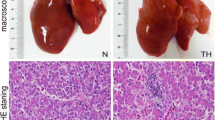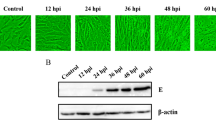Abstract
Maduramicin, an excellent ionophore antibiotic, is extensively used to control coccidiosis in poultry. Numerous maduramicin intoxications have been reported in farm animal and human due to its relatively narrow safety range, with necrosis or degeneration of cardiac and skeletal muscles as hallmark. To date, the mechanisms of maduramicin-induced cardiotoxicity remain unclear in chicken and other animals. Maduramicin (5 µg/mL)-treated primary chicken myocardial cells were used for RNA sequencing (RNA-Seq) and bioinformatics analysis in this study. A total of 1442 differential expressed genes were identified. 810 genes were up-regulated and the rest 632 genes were down-regulated. Transcriptome analysis revealed that the cytokine–cytokine receptor interaction, apoptosis, calcium signal and cytoplasmic vacuolization pathways were significantly affected. Real-time quantitative polymerase chain reaction (RT-qPCR) analysis showed that gene expression patterns were consistent with RNA-Seq analysis. Pro-inflammatory cytokines including tumor necrosis factor alpha (TNF-α) and interleukin-8 (IL-8), apoptosis ratios, cleaved caspase-3, intracellular calcium level and Ca2+-ATPase activity were elevated after maduramicin (0.05, 0.5 and 5 µg/mL) treatment. Massive vacuole formation was found in the cytoplasm by morphology and transmission electron microscopy observation. Taken together, the results suggested that maduramicin exerted its cardiotoxicity by multiple molecular mechanisms in primary chicken myocardial cells.









Similar content being viewed by others
References
Aki T, Nara A, Uemura K (2012) Cytoplasmic vacuolization during exposure to drugs and other substances. Cell Biol Toxicol 28(3):125–131. https://doi.org/10.1007/s10565-012-9212-3
Blain M, Garrard A, Poppenga R, Chen B, Valento M, Halliday Gittinger M (2017) Survival after severe rhabdomyolysis following monensin ingestion. J Med Toxicol 13(3):259–262. https://doi.org/10.1007/s13181-017-0616-6
Boehmerle W, Endres M (2011) Salinomycin induces calpain and cytochrome c-mediated neuronal cell death. Cell Death Dis 2:e168. https://doi.org/10.1038/cddis.2011.46
Caldeira C, Neves WS, Cury PM, Serrano P, Baptista MA, Burdmann EA (2001) Rhabdomyolysis, acute renal failure, and death after monensin ingestion. Am J Kidney Dis 38(5):1108–1112. https://doi.org/10.1053/ajkd.2001.28618
Calo M, Lo Cascio P, Licata P, Richetti A, Zaccone G, Naccari F (2002) Effects of monensin on Na+/K(+)-ATPase and Ca(++)-ATPase activities in chick skeletal muscle and myocardium after subacute treatment. Eur J Histochem 46(4):309–315
Chen M, Zhang M, Borlak J, Tong W (2012) A decade of toxicogenomic research and its contribution to toxicological science. Toxicol Sci 130(2):217–228. https://doi.org/10.1093/toxsci/kfs223
Chen X, Gu Y, Singh K et al (2014) Maduramicin inhibits proliferation and induces apoptosis in myoblast cells. PLoS One 9(12):e115652. https://doi.org/10.1371/journal.pone.0115652
Donev B, Vladimirova A, Kodjuharov E (1997) Safety evaluation and anticoccidial efficacy of maduramicin from different origin in chickens. J Vet Phamacol Ther 20(SUPPL. 1):177–177
Dowling L (1992) Ionophore toxicity in chickens: a review of pathology and diagnosis. Avian Pathol 21(3):355–368. https://doi.org/10.1080/03079459208418854
Elmore S (2007) Apoptosis: a review of programmed cell death. Toxicol Pathol 35(4):495–516. https://doi.org/10.1080/01926230701320337
Folz SD, Lee BL, Nowakowski LH, Conder GA (1988) Anticoccidial evaluation of halofuginone, lasalocid, maduramicin, monensin and salinomycin. Vet Parasitol 28(1–2):1–9
Gabriele A, Georges B, Paul B et al (2011) Scientific opinion on safety and efficacy of Cygro® 10G (maduramicin ammonium α) for chickens for fattening. Efsa J 9(1):1952
Gupta PB, Onder TT, Jiang G et al (2009) Identification of selective inhibitors of cancer stem cells by high-throughput screening. Cell 138(4):645–659. https://doi.org/10.1016/j.cell.2009.06.034
Henics T, Wheatley DN (1999) Cytoplasmic vacuolation, adaptation and cell death: a view on new perspectives and features. Biol Cell 91(7):485–498
Huczynski A (2012) Polyether ionophores-promising bioactive molecules for cancer therapy. Bioorg Med Chem Lett 22(23):7002–7010. https://doi.org/10.1016/j.bmcl.2012.09.046
International Chicken Genome Sequencing Consortium (2004) Sequence and comparative analysis of the chicken genome provide unique perspectives on vertebrate evolution. Nature 432(7018):695–716 https://doi.org/10.1038/nature03154
Kanehisa M, Araki M, Goto S et al (2008) KEGG for linking genomes to life and the environment. Nucleic Acids Res 36(Database issue):D480–D484. https://doi.org/10.1093/nar/gkm882
Kashida Y, Takahashi A, Moto M et al (2006) Gene expression analysis in mice liver on hepatocarcinogenesis by flumequine. Arch Toxicol 80(8):533–539. https://doi.org/10.1007/s00204-006-0065-5
Kim SJ, Lim JY, Lee JN et al (2014) Activation of beta-catenin by inhibitors of glycogen synthase kinase-3 ameliorates cisplatin-induced cytotoxicity and pro-inflammatory cytokine expression in HEI-OC1 cells. Toxicol 320:74–82. https://doi.org/10.1016/j.tox.2014.01.013
Koo KH, Kim H, Bae YK et al (2013) Salinomycin induces cell death via inactivation of Stat3 and downregulation of Skp2. Cell Death Dis 4:e693. https://doi.org/10.1038/cddis.2013.223
Kouyoumdjian JA, Morita MP, Sato AK, Pissolatti AF (2001) Fatal rhabdomyolysis after acute sodium monensin (Rumensin) toxicity: case report. Arq Neuro-Psiquiat 59(3–A):596–598
Lee KW, Lillehoj HS, Jang SI et al (2013) Comparison of live Eimeria vaccination with in-feed salinomycin on growth and immune status in broiler chickens. Res Vet Sci 95(1):110–114. https://doi.org/10.1016/j.rvsc.2013.02.005
Liu CM, Hermann TE, Downey A et al (1983) Novel polyether antibiotics X-14868A, B, C, and D produced by a Nocardia. Discovery, fermentation, biological as well as ionophore properties and taxonomy of the producing culture. J Antibiot (Tokyo) 36(4):343–350
Liu T, Yang P, Chen H et al (2016) Global analysis of differential gene expression related to long-term sperm storage in oviduct of Chinese Soft-Shelled Turtle Pelodiscus sinensis. Sci Rep 6:33296. https://doi.org/10.1038/srep33296
Lu B, Kerepesi L, Wisse L, Hitchman K, Meng QXR (2007) Cytotoxicity and gene expression profiles in cell cultures exposed to whole smoke from three types of cigarettes. Toxicol Sci 98(2):469–478
Lu D, Choi MY, Yu J, Castro JE, Kipps TJ, Carson DA (2011) Salinomycin inhibits Wnt signaling and selectively induces apoptosis in chronic lymphocytic leukemia cells. Proc Natl Acad Sci USA 108(32):13253–13257. https://doi.org/10.1073/pnas.1110431108
Madej JA, Mazurkiewicz M, Kuryszko J, Gawel A (1993) Histological and ultrastructural examination of muscles in broilers administered tiamulin together with ionophoric anticoccidials. Arch Vet Pol 33(1–2):5–17
Mao X, Cai T, Olyarchuk JG, Wei L (2005) Automated genome annotation and pathway identification using the KEGG Orthology (KO) as a controlled vocabulary. Bioinformatics 21(19):3787–3793. https://doi.org/10.1093/bioinformatics/bti430
Munir K, Muneer MA, Tiwari A, Chaudhry RM, Muruganandan S (2007) Effects of polyether ionophores on the protective immune responses of broiler chickens against Angara disease and Newcastle disease viruses. Vet Res Commun 31(7):909–929. https://doi.org/10.1007/s11259-007-0030-7
Munir K, Muneer MA, Tiwari A, Masaoud E, Chaudhry RM (2009) Effects of salinomycin on cell-mediated immunity of broiler chickens against hydropericardium syndrome and Newcastle disease viruses. Poult Sci 88(1):86–91. https://doi.org/10.3382/ps.2008-00345
Nagahama M, Itohayashi Y, Hara H et al (2011) Cellular vacuolation induced by Clostridium perfringens epsilon-toxin. FEBS J 278(18):3395–3407. https://doi.org/10.1111/j.1742-4658.2011.08263.x
Novilla MN (1992) The veterinary importance of the toxic syndrome induced by ionophores. Vet Hum Toxicol 34(1):66–70
Novilla MN (2007) Ionophores. In: Gupta RC (ed) Veterinary toxicology: basic and clinical principles. Elsevier-AP, Amsterdam, pp 1021–1041. https://doi.org/10.1016/B978-012370467-2/50180-2
Oehme FW, Pickrell JA (1997) The comparative toxicology of polyether ionophores. J Vet Pharmacol Ther 20(suppl. 1):326–326
Oehme FW, Pickrell JA (1999) An analysis of the chronic oral toxicity of polyether ionophore antibiotics in animals. Vet Hum Toxicol 41(4):251–257
Ouyang L, Shi Z, Zhao S et al (2012) Programmed cell death pathways in cancer: a review of apoptosis, autophagy and programmed necrosis. Cell Prolif 45(6):487–498. https://doi.org/10.1111/j.1365-2184.2012.00845.x
Overmeyer JH, Young AM, Bhanot H, Maltese WA (2011) A chalcone-related small molecule that induces methuosis, a novel form of non-apoptotic cell death, in glioblastoma cells. Mol Cancer 10:69. https://doi.org/10.1186/1476-4598-10-69
Piret JP, Jacques D, Audinot JN et al (2012) Copper(II) oxide nanoparticles penetrate into HepG2 cells, exert cytotoxicity via oxidative stress and induce pro-inflammatory response. Nanoscale 4(22):7168–7184. https://doi.org/10.1039/c2nr31785k
Porter AG, Janicke RU (1999) Emerging roles of caspase-3 in apoptosis. Cell Death Differ 6(2):99–104. https://doi.org/10.1038/sj.cdd.4400476
Portt L, Norman G, Clapp C, Greenwood M, Greenwood MT (2011) Anti-apoptosis and cell survival: a review. Biochim Biophys Acta 1813(1):238–259. https://doi.org/10.1016/j.bbamcr.2010.10.010
Raspe C, Czeslick E, Weimann A et al (2013) Glutamine and alanine-induced differential expression of intracellular IL-6, IL-8, and TNF-alpha in LPS-stimulated monocytes in human whole-blood. Cytokine 62(1):52–57. https://doi.org/10.1016/j.cyto.2013.02.020
Sanford SE, McNaughton C (1991) Ontario. Inonophore (maduramicin) toxicity in pigs. Can Vet J 32(9):567
Scherzad A, Hackenberg S, Schramm C et al (2015) Geno- and cytotoxicity of salinomycin in human nasal mucosa and peripheral blood lymphocytes. Toxicol In Vitro 29(4):813–818. https://doi.org/10.1016/j.tiv.2015.01.018
Sharma N, Bhalla A, Varma S, Jain S, Singh S (2005) Toxicity of maduramicin. Emerg Med J 22(12):880–882. https://doi.org/10.1136/emj.2004.020883
Shimshoni JA, Britzi M, Pozzi PS et al (2014) Acute maduramicin toxicosis in pregnant gilts. Food Chem Toxicol 68:283–289. https://doi.org/10.1016/j.fct.2014.03.034
Shlosberg A, Perl S, Harmelin A et al (1997) Acute maduramicin toxicity in calves. Vet Rec 140(25):643–646
Shubin AV, Demidyuk IV, Komissarov AA, Rafieva LM, Kostrov SV (2016) Cytoplasmic vacuolization in cell death and survival. Oncotarget 7(34):55863–55889. https://doi.org/10.18632/oncotarget.10150
Siddiqui WA, Ahad A, Ahsan H (2015) The mystery of BCL2 family: Bcl-2 proteins and apoptosis: an update. Arch Toxicol 89(3):289–317. https://doi.org/10.1007/s00204-014-1448-7
Singh T, Gupta RP (2003) Clinico-haematological and mineral studies on experimental maduramicin toxicity in chickens. Vet Parasitol 116(4):345–353
Sivakumar S, Reddy KS, Reddy AG, Kalakumar B, Anjaneyulu Y (2007) A study on maduramicin toxicity and its amelioration by ginseng in broiler chicks. Toxicol Int 14(2):137–141
Trabbic CJ, Overmeyer JH, Alexander EM et al (2015) Synthesis and biological evaluation of indolyl-pyridinyl-propenones having either methuosis or microtubule disruption activity. J Med Chem 58(5):2489–2512. https://doi.org/10.1021/jm501997q
Vleet JF, Ferrans VJ, Herman E (1991) Cardiovascular and Skeletal Muscle Systems. In: Hascheck WM, Rousseaux CG (eds) Handbook of Toxicologic Pathology: 19. Elsevier, San Diego, pp 539–624
Wan LY, Woo CS, Turner PC, Wan JM, El-Nezami H (2013) Individual and combined effects of Fusarium toxins on the mRNA expression of pro-inflammatory cytokines in swine jejunal epithelial cells. Toxicol Lett 220(3):238–246. https://doi.org/10.1016/j.toxlet.2013.05.003
Wang C, Chen T (2012) Intratumoral injection of taxol in vivo suppresses A549 tumor showing cytoplasmic vacuolization. J Cell Biochem 113(4):1397–1406. https://doi.org/10.1002/jcb.24012
Wang Z, Gerstein M, Snyder M (2009) RNA-Seq: a revolutionary tool for transcriptomics. Nat Rev Genet 10(1):57–63. https://doi.org/10.1038/nrg2484
Wasik AM, Almestrand S, Wang X et al (2011) WIN55,212-2 induces cytoplasmic vacuolation in apoptosis-resistant MCL cells. Cell Death Dis 2:e225. https://doi.org/10.1038/cddis.2011.106
Wentzel JF, Lombard MJ, Du Plessis LH, Zandberg L (2017) Evaluation of the cytotoxic properties, gene expression profiles and secondary signalling responses of cultured cells exposed to fumonisin B1, deoxynivalenol and zearalenone mycotoxins. Arch Toxicol 91(5):2265–2282. https://doi.org/10.1007/s00204-016-1872-y
Wu D, Zhang M, Xu J et al (2016) In vitro evaluation of aspirin-induced HspB1 against heat stress damage in chicken myocardial cells. Cell Stress Chaperon 21(3):405–413. https://doi.org/10.1007/s12192-016-0666-8
Young MD, Wakefield MJ, Smyth GK, Oshlack A (2010) Gene ontology analysis for RNA-Seq: accounting for selection bias. Genome biol 11(2):R14. https://doi.org/10.1186/gb-2010-11-2-r14
Zhao Q, Shao L, Hu X et al (2013) Lipoxin a4 preconditioning and postconditioning protect myocardial ischemia/reperfusion injury in rats. Mediat Inflamm 2013:231351. https://doi.org/10.1155/2013/231351
Acknowledgements
The authors would like to acknowledge the assistance of Prof. Dr. Long Chen and Shile Huang. We also thank Jinhu Huang, Tengfei Liu, Yun Hu and Zohaib Ahmed Bhutto for helpful comments on the manuscript. This work was supported by grants from the National Natural Science Foundation of China (31672612, 31502120), the National Key Research and Development Program (2016YFD0501306) and a project funded by the Priority Academic Program Development of Jiangsu Higher Education Institutions (PAPD).
Author information
Authors and Affiliations
Corresponding authors
Ethics declarations
Conflict of interest
The authors declare that they have no conflict of interest.
Additional information
Drs. Shanxiang Jiang and Dawei Guo are co-senior authors.
Electronic supplementary material
Below is the link to the electronic supplementary material.
Rights and permissions
About this article
Cite this article
Gao, X., Peng, L., Ruan, X. et al. Transcriptome profile analysis reveals cardiotoxicity of maduramicin in primary chicken myocardial cells. Arch Toxicol 92, 1267–1281 (2018). https://doi.org/10.1007/s00204-017-2113-8
Received:
Accepted:
Published:
Issue Date:
DOI: https://doi.org/10.1007/s00204-017-2113-8




